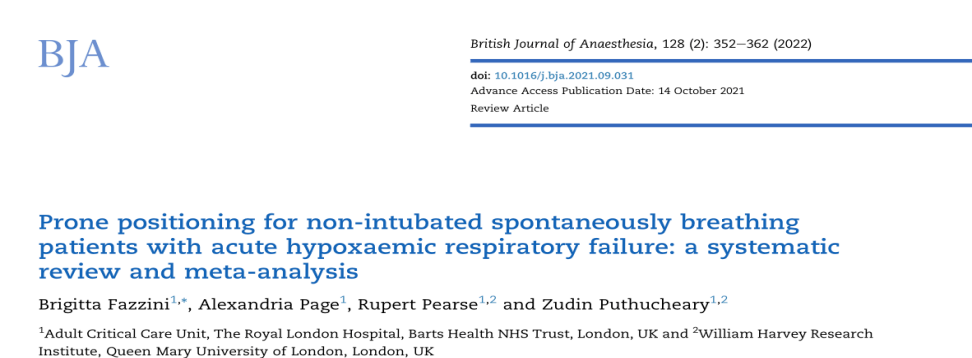
作者:罂粟花
关注罂粟花,共同学习麻醉最新文献!
急性低氧性呼吸衰竭时非插管自主呼吸患者的俯卧位应用:系统评价和Meta分析
贵州医科大学 麻醉与心脏电生理课题组
翻译:柏雪 编辑:马艳燕 审校:曹莹
背景:俯卧位在非插管自主呼吸患者中与无创呼吸支持一起被广泛应用于临床。本系统综述和Meta分析评估了与仰卧位相比,清醒俯卧位在急性低氧性呼吸衰竭患者的氧合、死亡率和气管插管方面的效果、时机和有效人群。
方法:我们对截止到2021年8月的PubMed/MEDLINE、Cochrane图书馆、Embase、CINAHL和BMJ Best Practice进行了系统的文献检索(国际前瞻性系统综述注册[PROSPERO]注册:CRD42021250322)。纳入的研究包括至少20例急性呼吸窘迫综合或新型冠状病毒肺炎(COVID-19)继发低氧性呼吸衰竭的成年患者。遵循系统评价和Meta分析首选报告项目(PRISMA)指南,使用NewcastleeOttawa量表和Cochrane偏倚风险工具评估研究质量。
结果:14 项研究符合选择标准,共纳入 2352 名患者;在这些患者中,99%(n= 2332/2352)患有 COVID-19。在俯卧位的 1041 名(44%)患者中,1021 名 SARS-CoV-2 呈阳性。Meta分析显示俯卧位后PaO2 / FiO2比率显着改善(平均差 –23.10;95%CI:–34.80 -11.39;P= 0.0001;I2=26%)。在 COVID-19 患者中,俯卧位组死亡率较低(俯卧位150/771对391/1457 仰卧位;优势比 [OR] 0.51;95% CI:0.32–0.80;P= 0.003;I2= 48%),但气管插管率没有变化(俯卧位284/824,仰卧位616/1271;OR 0.72;95% CI:0.43–1.22;P=0.220;I2=75%)。患者俯卧位的耐受时间中位数为4小时(四分位间距:2-16)。
结论: 在急性低氧性呼吸衰竭每天重复发作时,至少采用4小时俯卧位可以改善非插管急性低氧性呼吸衰竭患者的氧合。清醒俯卧似乎是安全的,但对气管插管率和生存率的影响仍不确定。
原始文献来源:Brigitta Fazzini , Alexandria Page, Rupert Pearse, et, al. Prone positioning for non-intubated spontaneously breathing patients with acute hypoxaemic respiratory failure: a systematic review and meta-analysis. British Journal of Anaesthesia, 128 (2): 352-362 (2022).
英文原文:
Prone positioning for non-intubated spontaneously breathing patients with acute hypoxaemic respiratory failure: a systematic review and meta-analysis
Background:Prone positioning in non-intubated spontaneously breathing patients is becoming widely applied in practice alongside noninvasive respiratory support. This systematic review and meta-analysis evaluates the effect, timing, and populations that might benefit from awake proning regarding oxygenation, mortality, and tracheal intubation compared with supine position in hypoxaemic acute respiratory failure.
